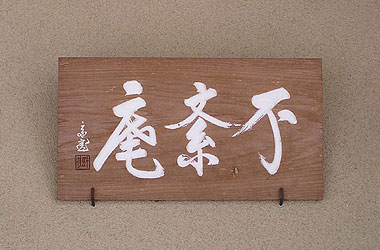1 Also
called *gaku 額. A tablet or board, framed or unframed, on which the
name of tea ceremony room or copies of inscriptions by Zen priests, revered
tea masters or famous people are carved. In some instances the background
has been chiseled away leaving the characters raised. Very rarely, this
type of inscription is written on paper. Typically, the wood used includes;
cedar, pine, zelkova, cypress or cinnamon wood, katsura 桂. After
the carving is completed, Chinese white or a bluish-green is used to bring
out the form of the characters. The frames are usually rectangular, oblong
or round. Sometimes no frame is used and the edges of the board are left
rough or hammered. The name may be followed by such characteristic appellations
as an 庵 (hermitage retreat); tei 亭 (arbor/cottage); sai
斎 (room/equal); seki 席 (room/straw mat); kyo 居 (residence/remain
sitting); dou 堂 (temple/reception room); ken 軒 (eaves/house counter)
etc. The tablets are hung outside on the gable wall, tsumakabe 妻壁,
protected by overhanging eaves *noki-no-de
軒の出, over the crawl-in entrance *nijiriguchi
躙口, under the pent roof *tsuchibisashi
土廂, or inside. Generally though, the host was free to hang the tablets at
his own discretion. Even two tablets, one inside and one out, could be hung,
or none at all. Examples: Omotesenke Mu-ichibutsu 表千家無一物 in Kyoto, Urakuen
Jo'an 有楽宛如庵 in Aichi prefecture. Shourinji
no Chatei, 少林寺の茶亭 in Okayama prefecture.
2 Plaques carved with the names of buildings and hung from the eaves
of gates or doors. This custom probably began in China during the Qin
dynasty. During the Tang dynasty, it became customary for the emperor to
offer a framed inscription when a Buddhist temple was built. This custom
was transmitted to Japan, where carved wooded plaques can be found at the
entrance gates of temples and shrines. One of the oldest examples is at
Toudaiji 東大寺. Framed paintings, calligraphy, as well as *ema
絵馬, votive paintings of horses and other subjects on wood, were also popularly
hung at temples and shrines.
|



